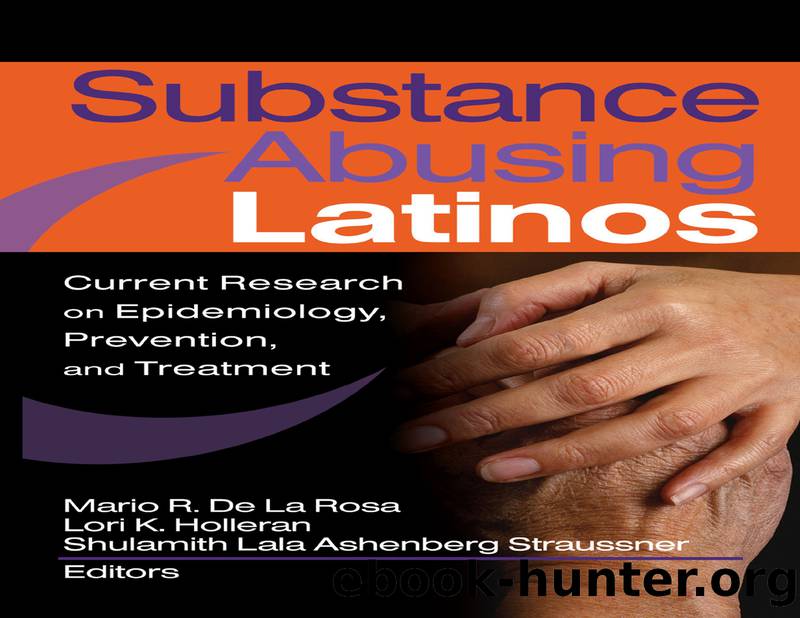Substance Abusing Latinos by Straussner Shulamith L. A.;De La Rosa Mario;Holleran Lori;

Author:Straussner, Shulamith L. A.;De La Rosa, Mario;Holleran, Lori;
Language: eng
Format: epub
Publisher: Taylor & Francis Group
Published: 2005-08-15T00:00:00+00:00
Acculturation And Substance Use
Acculturation refers to individual-level as well as community-level changes in values, behaviors and preferred modes of expression that occur as a result of contact between two cultures (Berry, Poortinga, Segall, & Dasen, 1992). Especially for recent immigrants, acculturation involves a kind of socialization into mainstream conceptions of ethnicity and a reorientation that balances two conflicting needsâto preserve the culture of origin and yet become part of the new culture.
Research connecting acculturation to substance use has focused on protective social and personal factors that may stem from continued attachment to the culture of origin, and their weakening through acculturative processes that expose youth to risk behaviors through more acculturated peers, declining parental and family influence, and increasing acculturation-related stress. Aspects of traditional Mexican culture like familism, a cultural orientation that gives primacy to the family of origin even after marriage, have been associated with greater resilience to substance use. Mexican and Mexican-American families have been shown to have stronger family pride, family closeness and respect for parents, mutual obligation, trust, and cohesion than European American families (Chandler, Tsai, & Wharton, 1999). Traditional Mexican norms such as parental monitoring and involvement with children and the stress on geographic proximity of extended family members may also act protectively as they provide children with more attention from caring adults, and situate children in more cohesive communities (Chandler et al., 1999; Denner, 2001). On the other hand, migration can dislocate families and seriously limit their ability to rely upon relatives, compadres (ritualistic relatives) and friends (Menjivar, 2000; Patterson & Marsiglia, 2000). These protective aspects of culture can be weakened by acculturation and acculturation stress, resulting in greater vulnerability to substance use (De La Rosa, 2002).
Research has linked acculturation processes with higher levels of substance use as well as lowered educational aspirations for children of Mexican descent, both among immigrants and U.S.-born children (Samaniego & Gonzales, 1999; Vega & Gil, 1999). Language figures prominently in explanations for this connection. Some adolescents who are Spanish dominant appear sheltered from a developmentally driven expansion of their social networks that enables them to access the broader community and enter new situations where substances are offered, putting them at higher risk for substance use (Escobar, 1998; Gil and Wagner, 2000; Marsiglia & Waller, 2002; Marsiglia, Kulis, Hecht, & Sills, 2004). Because adults learn English more slowly than children do, acquisition of and preference for English by children in non-English proficient families can lead to an erosion of protective family ties and communication, and reinforce behaviors of the mainstream culture that cause value conflicts with the culture of origin (Marsiglia, Miles, Dustman, & Sills, 2002; Vega, Zimmerman, Warheit, Apospori, & Gil, 1997).
Download
This site does not store any files on its server. We only index and link to content provided by other sites. Please contact the content providers to delete copyright contents if any and email us, we'll remove relevant links or contents immediately.
Application of a Novel Technique for Clinical Evaluation of Nitric Oxide-Induced Free Radical Reactions in ICU Patients by Unknown(696)
Rosenâs Emergency Medicine Concepts and Clinical Practice by Ron Walls; Robert Hockberger; Marianne Gausche-Hill; Timothy B. Erickson; Susan R. Wilcox(574)
Oxidative damage to surfactant protein D in pulmonary diseases by Vitality Starosta1 & Matthias Griese1†(410)
Social Science Perspectives on Global Public Health by Vincent La Placa & Julia Morgan(375)
Constructing Canine Consent; Conceptualising and Adopting a Consent-focused Relationship with Dogs by ERIN JONES(330)
Organic Chemistry: An Acid - Base Approach by MICHAEL SMITH(304)
ADVANCED EMERGENCY CARE AND TRANSPORTATION OF THE SICK AND INJURED by Unknown(272)
Saunders Nursing Drug Handbook 2024 - E-Book by Unknown(265)
Davis's Comprehensive Manual of Laboratory and Diagnostic Tests with Nursing Implications by Unknown(250)
Socio-Life Science and the COVID-19 Outbreak : Public Health and Public Policy by Makoto Yano; Fumihiko Matsuda; Anavaj Sakuntabhai; Shigeru Hirota(247)
Diagnostic and Statistical Manual of Mental Disorders, Fifth Edition, Text Revision (DSM-5-TR(tm)) by Unknown(246)
Human Microanatomy; Cell Tissue and Organ Histology with Celebrity Medical Histories by Stephen A. Stricker(245)
Berne and Levy Physiology E-Book by Unknown(237)
Replacing the Dead by Mie Nakachi;(232)
Handbook of Skin Disease Management by Jiyad Zainab;Flohr Carsten; & Carsten Flohr(230)
Access to Medicines and Vaccines in the South : Coherence of Rules and Policies Applied by the European Union Commission by Stephen Kingah(227)
Deep Learning and Medical Applications by Unknown(222)
The Pocket Guide to Sensorimotor Psychotherapy in Context (Norton Series on Interpersonal Neurobiology) by Pat Ogden(219)
Advances and Technical Standards in Neurosurgery by Unknown(215)
